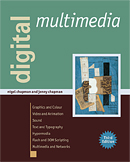
See the book at amazon.co.uk or amazon.com
Related Books

See Digital Multimedia at amazon.co.uk or amazon.com

See Web Design: A Complete Introduction at amazon.co.uk or amazon.com
The authors are not responsible for the content of any external sites linked to from digitalmediatools.org
All material on this site is ©2007–2010 MacAvon Media and may not be reproduced without permission.
Photoshop Hints and Tips
Is the Background Layer Locked?
Well, yes and no, but mostly no. The background layer always has a padlock icon attached to it, and in some senses it is locked. There are certain things you cannot do to it. However, for most purposes it does not behave like any other locked layer. For example, if you try to delete or erase part of any other locked layer, you will find the command greyed out or that the tool has no effect. But you can delete or erase part of the background layer without any difficulty. For this reason you should be cautious. It is advisable always to keep a safe and unaltered copy of an original image as a separate document (to go back to later for whatever reason), never to work on the background layer itself – duplicate it and work on the duplicate layer – and, if you want a genuinely locked version of the background layer, duplicate it, lock the duplicate, and delete the original background layer (to avoid confusion).
If you are sure you have a safe copy of your file, and you want to be able to alter the background in every possible way, the Layer>New>Layer from Background... command will effectively turn the background into an ordinary unlocked layer.
Which Layer Are You On?
It is frustratingly common to find that the layer you think you are working on is not the layer you are actually on. In particular, after applying an adjustment layer you may try to make some change to one of the main content layers and find that nothing seems to happen. This is almost certainly because you still have the adjustment layer selected. When you create an adjustment layer it will remain selected until you explicitly select another layer. Indeed, any layer you have been working on will remain selected until you select another layer. There is no quick fix to this – you just have to make sure that you know which layer you are on. If changes don't seem to be having any effect, look at the Layers panel, where the layer you are on will be highlighted.
Selection Marquee Options
The selection marquee has three different options, found under the Style pop-up menu on the Options bar: Normal, Fixed Ratio and Fixed Size. The latter two can be invaluable and you may find you use them frequently, but it is very easy to forget that you have chosen one of them (and applied settings). Photoshop remembers the option and settings you last chose, and does not revert to Normal. So if, after doing various other things, you try to make a marquee selection again, it will use the last settings you specified. If you have forgotten this can be very annoying. So, before you try to make a careful marquee selection, make sure you know which options you are using.
This tip also applies to the Crop Tool.
Precise Cursors
Photoshop's Cursors preferences offer several options for displaying the cursors associated with the various tools. The Painting Cursors setting is used for all brush tools, including erasers and the healing brush, while the Other Cursors setting affects selection tools and so on. Choosing Precise in both of these causes the cursor to be shown as a cross hair, which makes it much easier to see exactly where the tool is positioned on the image. For making precise marks and selections, this is invaluable. The drawback of using precise cursors is that you cannot tell immediately which tool you are using. The Standard setting uses the tool's icon as the cursor, so you always know which tool you are using, but do not have such a precise indication of its position. The other settings for the painting tools offer different compromises between these two options. Experiment to see which you like best.
Text in Photoshop
It can be very tempting to apply text in Photoshop when creating bitmapped layouts and designs, but Photoshop handles text inefficiently and multiple text layers can slow down processing considerably. Now that Illustrator can apply Photoshop effects, it is a better choice for work with text in many cases. Just place your Photoshop file in your Illustrator document and do the text work there.